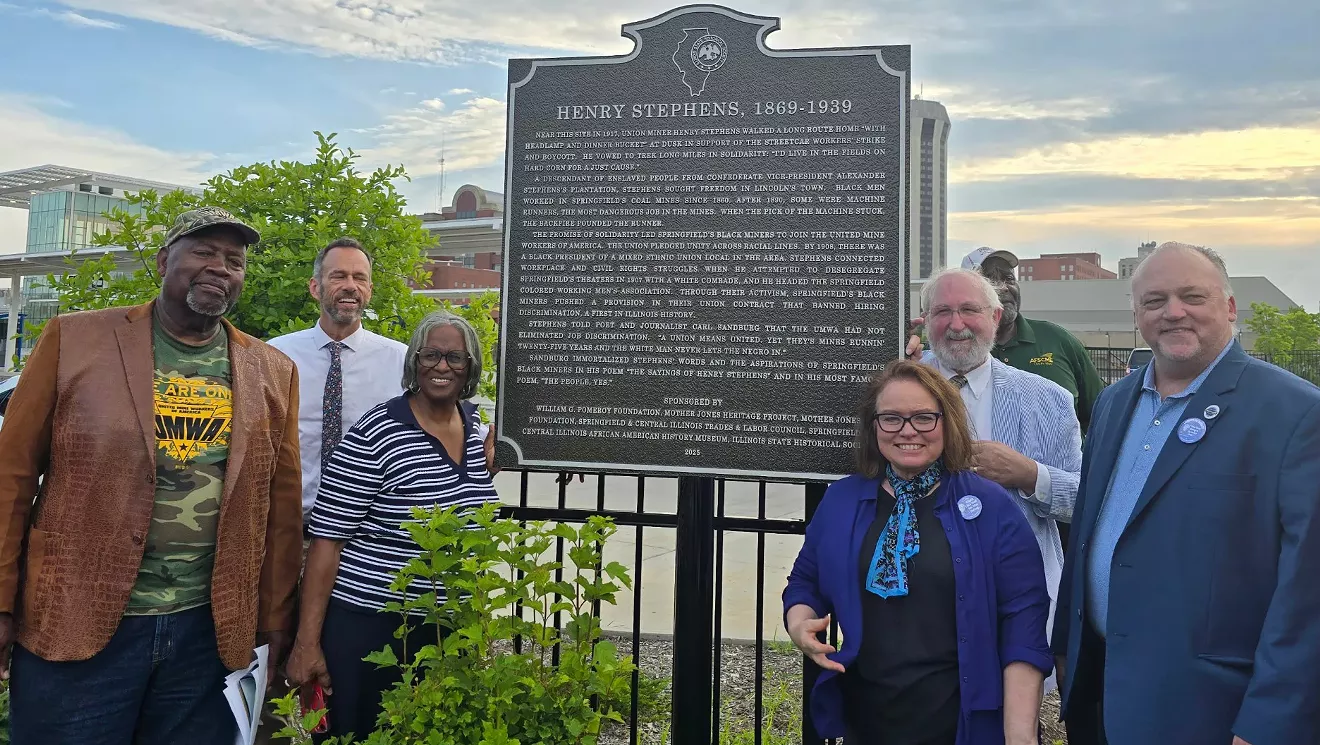
PHOTO BY MIRANDA BAILEY-PEETZ
At the June 17 dedication of the Henry Stephens historical marker are, from left, retired coal miner Willie McGuire, Charlie Stratton of the Springfield Mass Transit District, Sen. Doris Turner, Dr. Rosemary Feurer of Northern Illinois University, William Furry, executive director, Illinois State Historical Society, Willett Douglass, president of Black Trade Unionists and Nick Yelvington, Springfield and Central Illinois Trades and Labor Council. At the dedication, Willie McGuire read Carl Sandburg’s poem, “The Sayings of Henry Stephens.”
Henry Stephens, a Springfield resident and civil rights advocate in the late 1800s and early 1900s, was celebrated in two poems by Carl Sandburg. Now he is memorialized with a historical marker, which the Illinois State Historical Society officially unveiled June 17 at the Springfield Transportation Hub, on the southwest corner of 11th and Washington streets.
Stephens, who was an Alabama native before moving to Pana, and then Springfield in 1901, was an African American miner. Stephens was a descendant of enslaved people living on the Alabama plantation of Alexander Stephens, vice president of the Confederacy. He was an essential part of bringing equal rights into the mines, and to all jobs in Illinois.
Stephens moved to Pana in 1899 as a “scab worker,” meaning that he was replacing miners on strike because the Pana mines were unwilling to pay the going rate for their work. It was cheaper for the Pana mines to bring in new miners from Alabama, who they would then exploit. The scab miners coming in had been notified of the working conditions. This, combined with Pana’s reputation for racism, kept many African American workers from coming. However, some miners from Alabama, including Stephens, still came to Pana and protested for their rights there. Protests were led by Henry Stephens himself, and the final one ended in violence. Five African Americans were killed while protesting, and the National Guard had to be called in to quell the violence. Most African Americans fled Pana after this violence. But Stephens kept trying to fight for what he believed in.
Stephens moved to Springfield in 1901. It is obvious that at that point Stephens had reached his limit with the racism in the mines because he was quoted in the poem that Carl Sandburg wrote about him, The Sayings of Henry Stephens saying, “A Union means united. But they’s mines runnin’ twenty-five years and the white man never lets the negro in.” He also stated in the same text he would have to walk upwards of two miles to get to work. Stephens decided he needed to change this. He fought to get better working rights for miners in Springfield. He did so by helping lead Black miners to join the United Mine Workers of America, which promised to cross racial barriers and allow equal rights for Black and white miners alike. In 1908 Black miners made even more progress locally by gaining a Black president of a local mining union in Sangamon County.
Stephens can also be credited for trying to desegregate Springfield’s theaters. He partnered with a white man in 1907 to help. He was ultimately unsuccessful, but this did not deter him. Stephens became the president of the Springfield Working Men’s Association with the intention of helping push for civil rights in the workplace even more. With this organization, Stephens and other Black miners were able to win a provision in the union contract that banned hiring discrimination in the mines, the first provision of its kind in Illinois. Stephens also helped support transportation strikers in 1917 by walking a long way home during the sunset to support the streetcar workers’ strike. The strike achieved its goal of having the streetcar company recognize the union, meaning that there would be no more racially biased hiring. Stephens’ marker was erected close to the route that Stephens walked home.
Stephens is well known for saying, “I’d live in the fields on hard corn for a just cause.” That quote made its way into the poem, Sayings of Henry Stephens, in which Carl Sandburg wrote in the first person as Henry Stephens. The poem described Stephens’ thoughts about life as an African American in Springfield where he was facing prejudice and oppression. Stephens stated in the poem that he could only work at 8 out of 20 of the mines in Sangamon County just because he was not white. Stephens’ ideals were also mentioned in Carl Sandburg’s most famous poem, The People, Yes. Sandburg’s works not only strongly discouraged racism, but also memorialized Henry Stephens’ dedication to making Illinois a better place for everyone.
As a civil rights activist, Stephens helped change the state forever. The marker in his honor shows just how much of an impact he made.


